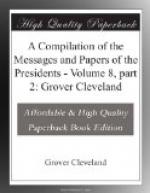The total coinage of all metals at our mints during the last fiscal year consisted of 63,485,220 pieces, valued at $106,216,730.06, of which there were $99,474,912.50 in gold coined, $758 in standard silver dollars, $6,024,140.30 in subsidiary silver coin, and $716,919.26 in minor coin.
During the calendar year 1893 the production of precious metals in the United States was estimated at 1,739,323 fine ounces of gold of the commercial and coinage value of $35,955,000 and 60,000,000 fine ounces of silver of the bullion or market value of $46,800,000 and of the coinage value of $77,576,000. It is estimated that on the 1st day of July, 1894, the stock of metallic money in the United States, consisting of coin and bullion, amounted to $1,251,640,958, of which $627,923,201 was gold and $624,347,757 was silver.
Fifty national banks were organized during the year ending October 31, 1894, with a capital of $5,285,000, and 79, with a capital of $10,475,000, went into voluntary liquidation. Twenty-one banks, with a capital of $2,770,000, were placed in the hands of receivers. The total number of national banks in existence on the 31st day of October last was 3,756, being 40 less than on the 31st day of October, 1893. The capital stock paid in was $672,671,365, being $9,678,491 less than at the same time in the previous year, and the surplus fund and individual profits, less expenses and taxes paid, amounted to $334,121,082.10, which was $16,089,780 less than on October 31, 1893. The circulation was decreased $1,741,563. The obligations of the banks to each other were increased $117,268,334 and the individual deposits were $277,294,489 less than at the corresponding date in the previous year. Loans and discounts were $161,206,923 more than at the same time the previous year, and checks and other cash items were $90,349,963 more. The total resources of the banks at the date mentioned amounted to $3,473,922,055, as against $3,109,563,284.36 in 1893.
From the report of the Secretary of War it appears that the strength of the Army on September 30, 1894, was 2,135 officers and 25,765 enlisted men. Although this is apparently a very slight decrease compared with the previous year, the actual effective force has been increased to the equivalent of nearly two regiments through the reorganization of the system of recruiting and the consequent release to regimental duty of the large force of men hitherto serving at the recruiting depots. The abolition of these depots, it is predicted, will furthermore effect an annual reduction approximating $250,000 in the direct expenditures, besides promoting generally the health, morale, and discipline of the troops.




